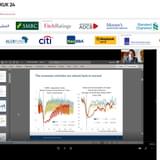Schildershoven Daily Intelligence, an emerging market fixed income research house, noted in a recent report that the move could help align offshore and onshore markets, help create a more stable exchange rate, and strengthen the Chinese securities markets.
In January this year the offshore yuan, the CNH, peaked at around 6.7000 whilst the onshore currency, the CNY, traded at just under 6.6000 according to Bloomberg, the largest ever gap between the two.
“The segregated money markets only limit volatility up to a point,” said Jose Brandao de Brito, Chief Economist at Millennium BCP.
Brito added that a unified FX system would also help develop a bond market in which international investors would be able to park their money in renminbi.
The yuan would likely be traded on an increased level internationally through a fully developed securities market and unified exchange rate.
“If you open the inland debt securities market to foreigners then you increase liquidity, which will make investing in yuan more appealing.”
Despite the risk of sparking capital outflows, allowing local onshore banks to trade in the offshore market would significantly reduce currency arbitrage according to Brito.
The Chinese have been trying to develop the yuan as an international reserve currency, and the renminbi is already set to enter the IMF’s Special Drawing Rights in October this year.
A merger of the onshore and offshore markets would certainly help with the internationalisation of the renminbi, Brito noted.
“The Chinese cannot have an international currency and at the same time a dual FX system.”
According to Bloomberg, the offshore yuan remains slightly weaker than its onshore equivalent by 0.1% yesterday. The difference last year was 0.3%. The onshore yuan is currently trading at 6.5800 to the US dollar, whilst according to Trading View, the offshore currency is currently at 6.58284 to the dollar.









